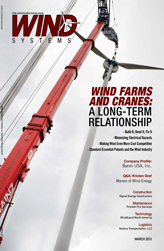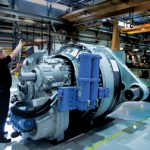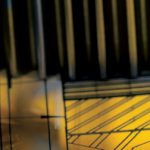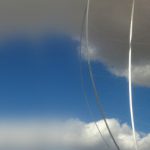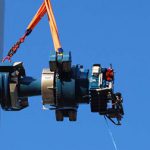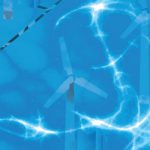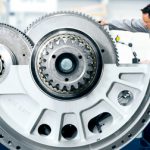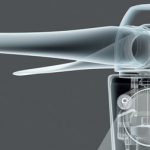Silent behemoths supporting 60-meter blades that rotate with tip speeds up to 300 km/h and weigh up to 15 metric tons, industrial wind turbines are modern engineering miracles. These sentinels of electric power often stand in excess of 150 meters tall and must withstand decades of harsh environmental conditions found offshore, in coastal regions and on mountaintops.
Industrial wind turbines cost roughly $1.2 million/MW to build based on a 1- to 3MW turbine. Installation costs increase the investment by a factor of 1.2 to 1.35 for onshore projects, with offshore installation costs being significantly higher. Turbine manufacturers and owners are constantly looking for ways to reduce manufacturing and maintenance costs and increase profitability by shortening production cycles, increasing production volume, and simplifying maintenance requirements. Figure 1
Adhesives, sealants, lubricants and surface treatments play critical roles in the life, health and financial soundness of wind turbines. These materials are used during every phase of manufacturing, installation and day-to-day operation.
Turbine Manufacturing and Assembly
For blade and nacelle production, gigantic molds are first treated with semi-permanent mold release agents that allow large-scale composite parts to be easily removed from the mold. Blade halves and nacelle body components are bonded together and sealed using structural adhesives such as two-part polyurethanes that prevent crack propagation, micro-cracking and fatigue, and ensure the long-term integrity of the structure. Two-part polyurethanes also fill voids found on the molded assemblies (see sidebar on polyurethane technology).
Two component polyurethane adhesives and MS polymer sealants are used to permanently bond components such as access doors, rain deflectors and gurney flaps to the blades. Color-matching, weather-resistant MS polymers and high performance sealants protect and seal the blade and nacelle interior and exterior from moisture and environmental contaminants.
When metal tower components are manufactured, surface treatments such as coatings, conversion coatings and cleaners/degreasers prepare the surface to improve corrosion resistance and paint adhesion. These large parts are then ready for assembly.
On the tower, sealants prevent moisture from penetrating in through tower section breaks and prevent corrosion on load support plates, platforms, bolt heads, ladder frames and other metal surfaces. Anaerobic threadlockers lock and seal large threaded fasteners. Structural adhesives are used to bond and secure ladders and other components.
Anaerobic adhesives play critical roles throughout the turbine assembly, locking and sealing threaded fasteners found on the base, tower, nacelle and blades. Anaerobic materials are widely used in hub, bearing and the gearbox assembly where they retain pitch and yaw bearings, and seal gearboxes, flanges and hydraulic fittings. Anti-seize lubricants protect power train splines, mounting bolts and exposed fasteners.
Throughout the turbine, heavy duty solvent-based and aqueous cleaners remove dirt and residues from composite and metal parts and prepare them for installation and operation in the field.
During installation, epoxy grout materials are used to create a level, secure base for tower assembly. High strength epoxy grouts bond to steel, concrete and other construction materials and withstand high torque loads. Urethane sealants bond, seal and waterproof tower bases. Cables that route out of the turbine to deliver electricity must be sealed to stop moisture/water from entering the turbine, preventing corrosion. Highly flexible silane modified polymers demonstrate good adhesion to many substrates and create a soft, elastic seal. Figure 2
| Polyurethane Adhesive Technology for Rotor Blade Bonding |
| Until recently, most wind blade manufacturers have used GL-certified two-component reactive epoxy resins to bond load-carrying structures like rotor blades. While epoxies offer excellent adhesion, shear strength and chemical/heat resistance, they are expensive to process, take a considerable length of time to cure completely (slowing the production cycle time), and generate extreme exotherm during cure, which may lead to crack formation. These limitations increase the risk for warranty claims and field repair, and can contribute to ultimate blade failure. A new high performance polyurethane adhesive technology (from Henkel Corporation, Macroplast® UK 1340™) is consistently contributing to the assembly of highly efficient wind turbines. This adhesive satisfies the specific mechanical requirements for use in the wind power industry, improves the long term reliability of rotor blades and makes rotor blade production faster and less expensive. New PUR technology provides excellent static and fatigue strength, excellent toughness, and resists crack propagation, while significantly improving the efficiency of rotor blade production. The new PUR requires fewer curing steps than epoxies, resulting in reduced assembly costs and 15 to 30 percent shorter production cycles. This improves payback time on critical investments such as molds and factory facilities, and decreases the number of required production lines. Additionally, the new PUR rapidly develops sufficient green strength for demolding, enabling demolding in a partially cured state followed by a freestanding postcure — a further lever to reduce production cycle time and costs. In addition to blade bonding, two component polyurethane adhesives can be used to attach components to the rotor blade, for nacelle assembly, and for securing the ladder to the tower assembly. GL requirements for adhesives primarily relate to shear strength, long-term durability, creep behavior and glass transition. The adhesive’s physical properties are temperature-dependent. Within a temperature range known as glass transition (Tg), the adhesive’s mechanical properties change considerably from brittle or glass-like at low temperatures to flexible or rubbery-elastic at the high end of the range. For rotor blades, GL requires a Tg of at least 65°C to prevent bond crep or relative movement of the substrates and achieve rigidity at higher ambient temperatures. However, typical polyurethane adhesives offer a range of only -30 to 45°C, depending on the desired elasticity. Offering breakthrough Tg better than typical polyurethanes, Macroplast® UK 1340™ is the only adhesive in its class to satisfy GL’s requirements. Extensive tests have also demonstrated a tensile shear strength exceeding 20 MPa in the -40 to +80° C temperature range and a Tg of 65°C and higher. This improved tensile fatigue strength allows wind blades to better handle deflection across the length of the blade and dynamic load and stress on the adhesive bond line, reducing the risk of damage that may require repair or replacement. The two-component PUR consists of a resin and a hardener. After mixing, pot life ranges from 30 to 90 minutes at 20°C, but can be adapted as required for a specific manufacturer’s production process without the disadvantage of partially overheating the adhesive joint. Manufacturers can maximize throughput without increasing stress in the part or the potential for stress cracking associated with high exotherm. The new PUR adhesive generates much lower exotherm of up to 75°C maximum when compared to the 120ºC – 150ºC exotherm of epoxies. Reducing exotherm benefits the process in two ways. First, when composite materials are bonded, stress cracking caused by excessive thermal loading may weaken the rotor blade as a whole. This risk is significantly reduced if the reaction temperature is lower. Second, high temperature polymerization is always accompanied by changes in volume. Low heat emissions and lower thermal loading during chemical crosslinking reduces heat related shrinkage in the bond line. Controlled shrinkage results in a more durable bond over time. The heat generated from an exothermic reaction will vary depending on the quantity of adhesive undergoing cure. In areas where larger amounts of adhesive are applied, temperatures get much hotter than in those areas with less adhesive volume. On a single rotor blade there are considerable differences in the quantity of adhesive applied and, therefore, considerable differences in stress. At the interfaces between such stress fields, mechanical flaws will occur, unless the stress is relieved through elaborate tempering. This is where polyurethane systems with low-temperature exothermic reactions have big advantages, particularly when applied in thick films. |
Turbine Maintenance
From the moment a turbine is assembled and begins to turn, it is exposed to environmental hazards. Lightning, turbulence, sand, rain, hail, snow and bird-strikes all contribute to wear and damage to the blades and nacelle. Corrosion affects the aesthetics and eventually compromises the strength of the tower, while erosion damages the concrete foundation, causing cracks, chips and spalling.
Composite blade tips commonly experience micro-cracking and structural cracking that can be significant and require installation of a new tip or a structural patch. Bird and lightning strikes can penetrate the blade and require repair to the core material, the blade substrate and the blade surface. Pitting and wear caused by weather and environmental elements can decrease the performance and efficiency of the wind turbine.
High viscosity, structural polyurethane putties are hand applied to the eroded edges of the blade to fill pitting and wear damage. Fast-curing, abrasion-resistant putties are used as a repair system along with polyurethane hand lay-up resins and polyurethane structural bonding adhesives, for damage caused by lightning or bird strikes. Cartridge dispensed two-component structural polyurethane adhesives bond patches for damaged tips. To reduce the chance of subsequent lightning strikes, lightning diverter strips designed to transmit and ground lightning away from the blades, can be applied to blade surfaces using a structural adhesive. Working together, these adhesives and sealants return the blades to their original smooth and wind-resistant design and allow the blades to rotate again with little downtime.
On and in the nacelle, sealants are used to protect the generator and motor housing, panels, hinges, service doors, manholes and exterior appliances such as wind indicators, lights, rails or cable breakthroughs from moisture ingress and corrosion. Anaerobic materials protect yaw bearings and keep gear boxes operating efficiently and reliably. Anti-slip coatings create walking surfaces with good traction so that maintenance workers will not slip in cold, wet and icy conditions outside the nacelle or slippery, lubricant and coolant-coated surfaces inside the nacelle.
The tower assembly must be treated on an ongoing basis with maintenance chemicals to keep it strong and solid throughout the long life of the turbine. High flexibility adhesives and sealants ensure the tower sections stay together and seal out water and chemicals that can cause corrosion and enter the tower assembly. Chemically resistant coatings and galvanizing compounds protect the metal towers from corrosion and damage. Threadlocking and structural adhesives keep accessories such as ladders and platforms in place and prevent threaded fastener failure.
To ensure that blades achieve maximum aerodynamic efficiency, they must be regularly cleaned of contaminations such as algae, dirt and sand. Water-based cleaners quickly cut through grime and reduce the effort and time required for cleaning. By applying specially formulated coatings, maintenance crews can reduce the likelihood of new contaminants sticking to the blades and can increase the turbine’s total power production until the next scheduled cleaning.
On the base of the turbine, damage and cracks in concrete pads will deteriorate over time from exposure to outside elements. Repairing damaged areas using crack fillers and fast-fixturing concrete repair products increases the life of the concrete structure and helps it resist future damage.
By incorporating adhesives, sealants and surface coatings from start to finish in wind turbine production, manufacturers can produce more robust turbine components and longer-lasting assemblies. Automated processes shorten production cycles, increase production volume and reduce manufacturing costs. And stronger, more reliable turbine components mean less maintenance when the turbine is assembled and in operation in the field.
During installation and maintenance, wind farms that use adhesives, sealants, lubricants, surface treatments and cleaners top to bottom on their turbines simplify and speed installation, minimize downtime and ensure a safe work environment. The turbines are more efficient, more reliable, and provide more energy over the expected lifespan.



















